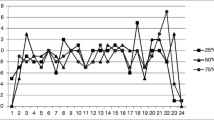Abstract
The problem of patient no-show in outpatient delivery systems has been a long recognized issue. The negative impacts include underutilized medical resources, increased healthcare costs, decreased access to care, and reduced clinic efficiency and provider productivity. Many clinics have cancellation policies of asking their patients to cancel 24 or 48 h in advance. However, there is no logical or mathematical basis for such a policy. The objective is to develop an effective cancellation policy that accounts for current no-show rates, the clinic's flow, and its fill rates to minimize the cost of patient wait time, physician idle time, and overtime. A simulation approach is presented to determine the hours required for patients to call in advance for cancelling appointments. The findings indicate that when fill rates are low and no-show probabilities are high, the time required for patients to cancel appointments needs to increase in order to achieve the goal of being cost-effective.






Similar content being viewed by others
References
Barron WM (1980). Failed appointments: Who misses them, why they are missed, and what can be done. Primary Care 7 (4): 563–574.
Bean AG and Talaga J (1992). Appointment breaking: Causes and solutions. Journal of Health Care Marketing 12 (4): 14–25.
Bean AG and Talaga J (1995). Predicting appointment breaking. Journal of Health Care Marketing 15 (1): 29–34.
Campbell JD, Chez RA, Queen T, Barcelo A and Patron E (2000). The no-show rate in a high-risk obstetric clinic. Journal of Women's Health and Gender-based Medicine 9 (8): 891–895.
Cayirli T and Veral E (2003). Outpatient scheduling in health care: A review of literature. Production and Operations Management 12 (4): 519–549.
Chariatte V, Michaud PA, Berchtold A, Akre C and Suris JC (2007). Missed appointments in an adolescent outpatient clinic: Descriptive analyses of consultations over 8 years. Swiss Medical Weekly 137 (47–48): 677–681.
Chatwin RE (1998). Multiperiod airline overbooking with a single fare class. Operations Research 46 (6): 805–819.
Deyo RA and Inui TS (1980). Dropouts and broken appointments: A literature review and agenda for future research. Medical Care 18 (11): 1146–1157.
Glowacka K, Henry R and May J (2009). A hybird data mining/simulation approach for modelling outpatient no-shows in clinic scheduling. Journal of the Operational Research Society 60 (8): 1056–1068.
Hashim MJ, Franks P and Fiscella K (2001). Effectiveness of telephone reminders in improving rate of appointment kept at an outpatient clinic: A randomized controlled trial. Journal of the American Board of Family Practice 14 (3): 193–196.
Ho C and Lau H (1992). Minimizing total cost in scheduling outpatient appointments. Management Science 38 (2): 1750–1764.
Huang Y and Zuniga P (2012). Dynamic overbooking scheduling system to improve patient access. Journal of the Operational Research Society 63 (6): 810–820.
Kapsambelis N (2005). 24-hour cancellation policy cuts down on costly no-shows. Getting Paid in Behavioral Healthcare 10 (3): 1–8.
Klassen KJ and Rohleder TR (1996). Scheduling outpatient appointments in a dynamic environment. Journal of Operations Management 14 (2): 83–101.
Kopach R, DeLaurentis P, Lawley M, Muthuraman K, Ozsen L, Rardin R, Wan H, Intrevado P, Qu X and Willis D (2007). Effects of clinical characteristics on successful open access scheduling. Journal of Health Care Management Science 10 (2): 111–124.
LaGanga LR and Lawrence SR (2007). Clinic overbooking to improve patient access and increase provider productivity. Decision Sciences 38 (2): 251–276.
Liu N, Ziya S and Kulkarni VG (2010). Dynamic scheduling of outpatient appointments under patient no-shows and cancellations. Manufacturing and Service Operations Management 12 (2): 347–364.
Oppenheim GL, Bergman JJ and English EC (1979). Failed appointments: A review. The Journal of Family Practice 8 (4): 789–796.
Rangsaritratsamee R, Ferrel WG and Kurz MB (2004). Dynamic rescheduling that simulataneously considers efficiency and stability. Computer and Industrial Engineering 46 (1): 1–15.
Rust CT, Callups NH, Clark WS, Jones DS and Wilcox WE (1995). Patient appointment failures in pediatric resident continuity clinics. Archives of Pediatrics & Adolescent Medicine 149 (6): 693–695.
Shonick W and Klein BW (1977). An approach to reducing the adverse effects of broken appointments in primary care systems: Developing a decision rule based on estimated conditional probabilities. Medical Care 15 (5): 419–429.
Vanden Bosch PM and Dietz DC (2000). Minimizing expected waiting in a medical appointment system. IIE Transactions 32 (9): 841–848.
Welch JD and Bailey NT (1952). Appointment systems in hospital outpatient deaprtments. The Lancet 1 (6718): 1105–1108.
Whittle J, Schectman G, Lu N, Baar B and Mayo-Smith MF (2008). Relationship of scheduling interval to missed and cancelled clinic appointments. The Journal of Ambulatory Care Management 31 (4): 290–302.
Woodcock EW (2006). Cancellations: Don’t let them erode your bottom line. Dermatology Times 27 (8): 82–86.
Author information
Authors and Affiliations
Corresponding author
Rights and permissions
About this article
Cite this article
Huang, Y., Zuniga, P. Effective cancellation policy to reduce the negative impact of patient no-show. J Oper Res Soc 65, 605–615 (2014). https://doi.org/10.1057/jors.2013.1
Received:
Accepted:
Published:
Issue Date:
DOI: https://doi.org/10.1057/jors.2013.1




